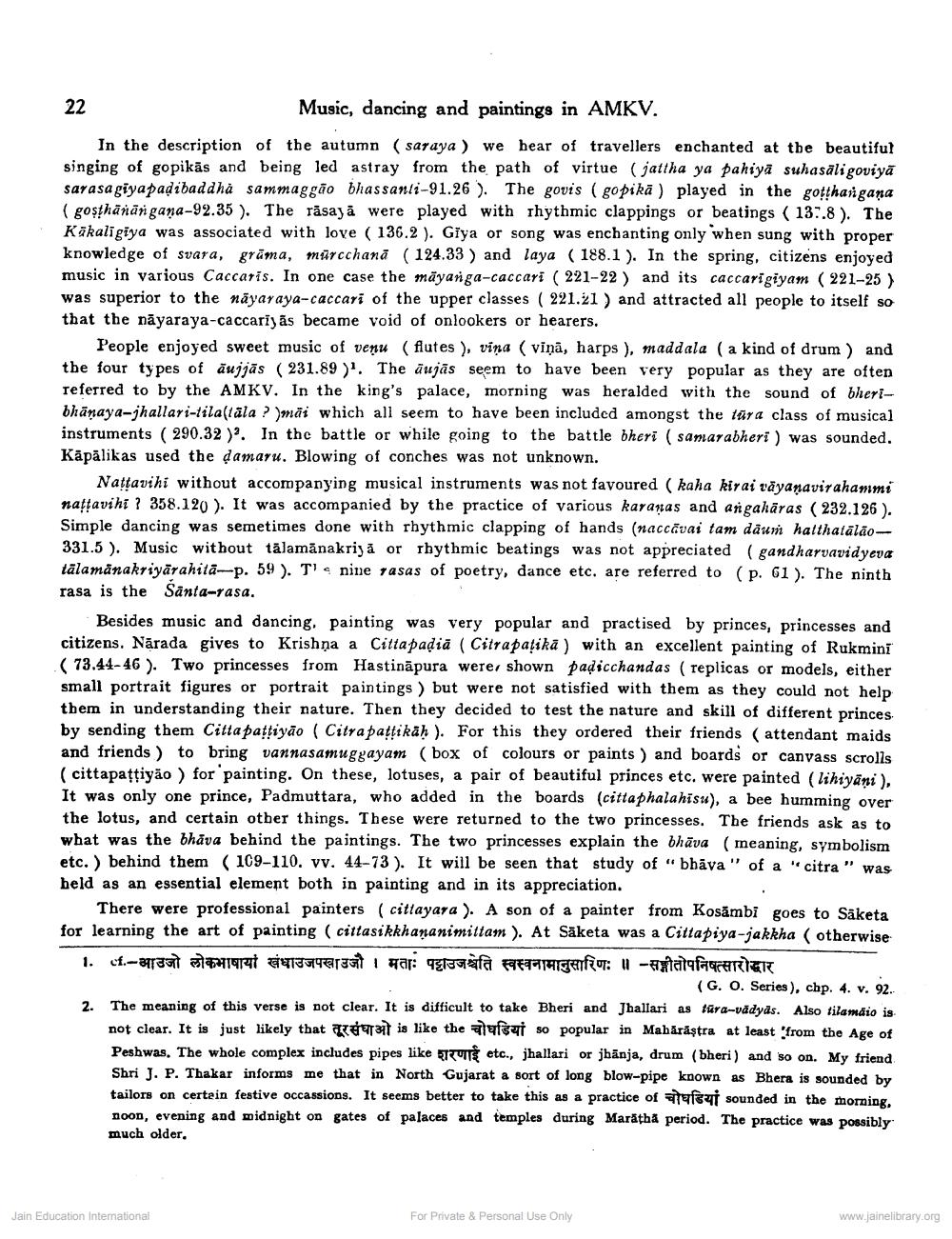________________
Music, dancing and paintings in AMKV.
In the description of the autumn (saraya ) we hear of travellers enchanted at the beautiful singing of gopikās and being led astray from the path of virtue (jattha ya pahiya suhasäli goviyā sarasa giyapadibaddha sammaggão bhassanli-91.26). The govis (gopika ) played in the gottharigana (gosthānārgana-92.35 ). The rāsajā were played with thythmic clappings or beatings ( 137.8). The Kākaligiya was associated with love ( 136.2 ). Giya or song was enchanting only when sung with proper knowledge of svara, grāma, mürcchanā (124.33 ) and laya (188.1). In the spring, citizens enjoyed music in various Caccaris. In one case the māyanga-caccari ( 221-22 ) and its caccarigiyam (221-25 ) was superior to the nāyaraya-caccari of the upper classes ( 221.21 ) and attracted all people to itself so that the nāyaraya-caccarījās became void of onlookers or hearers.
People enjoyed sweet music of venu (flutes ), viņa (viņā, harps ), maddala (a kind of drum ) and the four types of aujjās (231.89 )'. The äujās seem to have been very popular as they are often referred to by the AMKV. In the king's palace, morning was heralded with the sound of bheribhānaya-hallari-lilalala ? mai which all seem to have been included amongst the tara class of musical instruments ( 290.32). In the battle or while going to the battle bheri ( samarabheri ) was sounded. Kāpālikas used the damaru. Blowing of conches was not unknown.
Nattavihi without accompanying musical instruments was not favoured ( kaha kirai vāyaṇavir ahammi nattavihi ? 358.120 ). It was accompanied by the practice of various karanas and arigahāras (232.126 ). Simple dancing was semetimes done with rhythmic clapping of hands (naccävai tam daun halthatālão331.5). Music without tālamānakrijă or rhythmic beatings was not appreciated ( gandharvavidyeva tālamanakriyārahita--p. 59). Tie nine asas of poetry, dance etc. are referred to (p. 61). The ninth rasa is the Santa-tasa.
Besides music and dancing, painting was very popular and practised by princes, princesses and citizens. Nārada gives to Krishna a Cittapadia ( Citrapatika) with an excellent painting of Rukmini ( 73.44-46). Two princesses from Hastinapura were shown padicchandas (replicas or models, either small portrait figures or portrait paintings ) but were not satisfied with them as they could not help them in understanding their nature. Then they decided to test the nature and skill of different princes by sending them Citta pattiyão ( Citra pattikāḥ ). For this they ordered their friends (attendant maids and friends) to bring vannasamuggayam (box of colours or paints ) and boards or canvass scrolls (cittapattiyão ) for painting. On these, lotuses, a pair of beautiful princes etc. were painted (lihiyāni), It was only one prince, Padmuttara, who added in the boards (cittaphalahisu), a bee humming over the lotus, and certain other things. These were returned to the two princesses. The friends ask as to what was the bhāva behind the paintings. The two princesses explain the bhäva (meaning, symbolism etc.) behind them ( 109-110. vv. 44-73). It will be seen that study of " bhāva" of a "citra" was held as an essential element both in painting and in its appreciation.
There were professional painters ( cittayara ). A son of a painter from Kosambi goes to Säketa for learning the art of painting ( cittasikkhananimittam ). At Säketa was a Cittapiya-jakkha ( otherwise 1. ef.-आउजो लोकभाषायां खंधाउजपखाउजौ । मताः पट्टाउजश्चेति स्वस्वनामानुसारिणः ॥ -सङ्गीतोपनिषत्सारोद्धार
(G. O. Series ), chp. 4. v. 92. 2. The meaning of this verse is not clear. It is difficult to take Bheri and Jhallari as túra-vädyds. Also filamäio is
not clear. It is just likely that 3 is like the styf so popular in Mabărăştra at least from the Age of Peshwas. The whole complex includes pipes like BITUIS etc., jhallari or jbänja, drum (bheri) and so on. My friend Shri J. P. Thakar informs me that in North Gujarat a sort of long blow-pipe known as Bhera is sounded by tailors on certein festive occassions. It seems better to take this as a practice of tafeyi sounded in the morning, noon, evening and midnight on gates of palaces and temples during Maratha period. The practice was possibly much older.
Jain Education International
For Private & Personal Use Only
www.jainelibrary.org




